By Alison Stewart
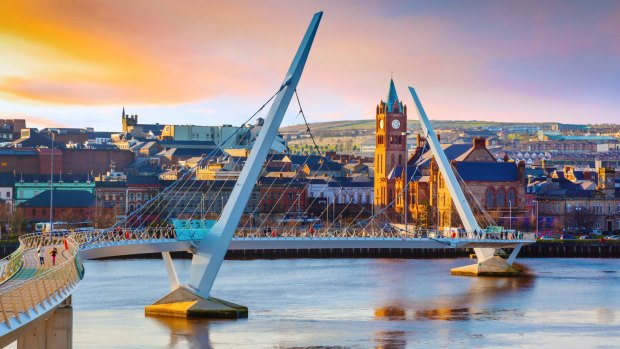
The Peace Bridge is a cycle and footbridge bridge across the River Foyle.Credit: Getty Images
On a scale of difficulty, walking backwards in sandals atop a slippery wall in lashing rain so your tour group can hear you expound creatively on 1500 years of Irish history, might just win the most challenging guiding award.
Our Derry guide for our city walls tour, John McNulty, might contend however that given the historic circumstances, walking backwards in lashing rain is the least of his (or Derry's) concerns.
This gorgeous city of 149,000 in County Londonderry, Northern Ireland, has had to endure long years of struggle, siege and skirmish, and has, remarkably, emerged as a picture-perfect place, enhanced rather than diminished by its hardship.
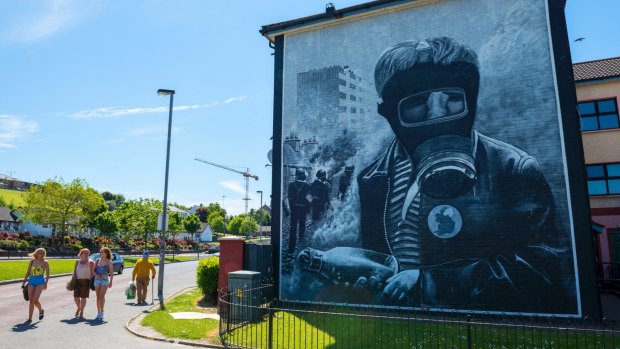
The Bogside, Derry.Credit: iStock
Derry, also known as Londonderry (though you sometimes see the "London" crossed out on street signs – nationalists generally favour Derry while unionists prefer Londonderry) is strategically positioned on the River Foyle. It's one of Ireland's longest inhabited places dating back to the sixth century and is the only remaining completely intact walled city in Ireland.
It's also regarded as one of the finest examples of a European walled city – high praise given the Europe's abundance of picturesque walled cities such as Carcassonne, Dubrovnik, Tallinn, Toledo, Saint-Malo and York.
If you do nothing else in Derry (which would be hard given its resurgent fine restaurants, music scene, regenerated historic places, late Georgian, Victorian and Edwardian architecture and excellent hotels), do the wall walk.
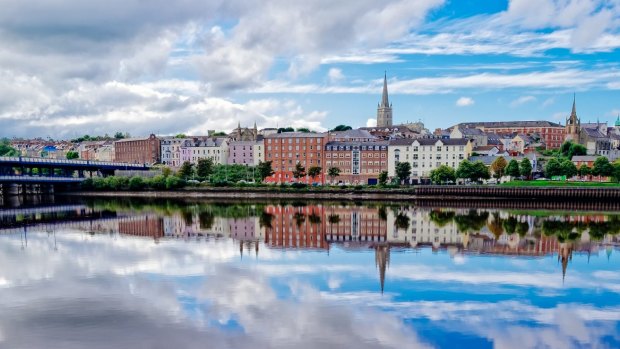
Derry from across the Foyle.Credit: iStock
As with many such walls, this one is a solid stone memorial to a people's metaphysical condition, as well as simply an elevated promenade from which to view the city, both within and without.
We have been swept into Derry on a rain front that is rushing north into Donegal and, windscreen wipers working overtime, have arrived at the enchanting sounding Bishop Street Within (inside the walled city).
Our destination is the lovely Edwardian Grade B1-listed Bishop's Gate Hotel in the heart of Derry City's Cathedral Quarter, just awarded "Hideaway of the Year 2017" at Dublin's Georgina Campbell Awards after a sympathetic restoration.
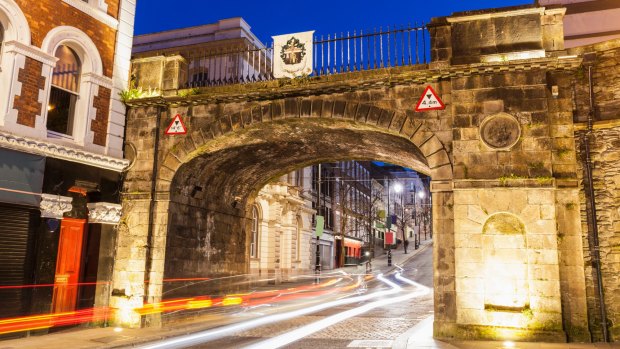
Derry's city wall is completely intact.Credit: iStock
Every instinct begs us to enjoy a hot shower and curl up in our elegant bedroom, watching the rain pounding our long sash windows. However, hotel general manager Ciaran O'Neill, who is charmingly handing out umbrellas at the concierge desk, urges us on to the walls, torrential rain or not.
We join a group huddled outside Ferryquay Gate and head off, wondering why everyone is speaking German. We've joined the wrong group – more than a few tours depart from this spot.
Second time around we find Martin McCrossan's City Tours' No.1 guide, the be-sandalled John, gathering his bedraggled herd, kindly letting the nearby busker know we'll be gone in a sec.
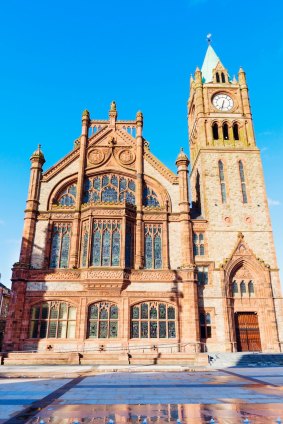
Guildhall in Derry. Credit: iStock
Walking backwards, John, taking no sides in the many conflicts, apart from the express desire for lasting peace, explains Derry and Irish history with empathy and humour.
Derry, we learn, derives from the old Irish word Daire meaning oak grove on an island. It's said the Irish saint Colmcille founded a monastery on a River Foyle island in 546AD, creating an important centre for Christianity in medieval times.
The stone and earthen walls are 3.6-metres to 10.6-metres-wide and about 1.5 kilometres in circumference, built between 1613 and 1618 as a defence for English and Scottish (Ulster Plantation) settlers during the early 17th century.
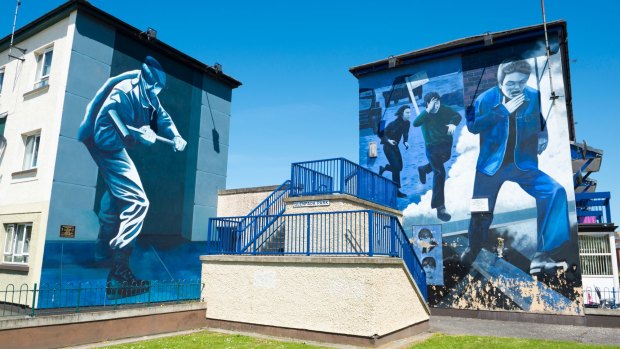
In the majority-Catholic community of Bogside in Derry, apartment buildings display politically-motivated murals.Credit: Getty Images
They've been a constant in Derry life, witnessing events both celebratory and tragic and have never been breached, withstanding all besieging armies.
With every step, John brings history alive, his stories adding colour to historic buildings and adjacent areas along the wall. We stop to hear about the "Londonderry West Bank Loyalists No Surrender" mural in the Ulster loyalist enclave, Fountain Estate, outside the walls, whose provenance goes back to the 1688 Siege of Derry.
During the time of the siege, when the walled city was a Protestant stronghold, half of Derry died from starvation or injury before the relief. The siege began when 13 apprentice boys shut the gates against Catholic King James II, who was greeted with the cry of "No Surrender".
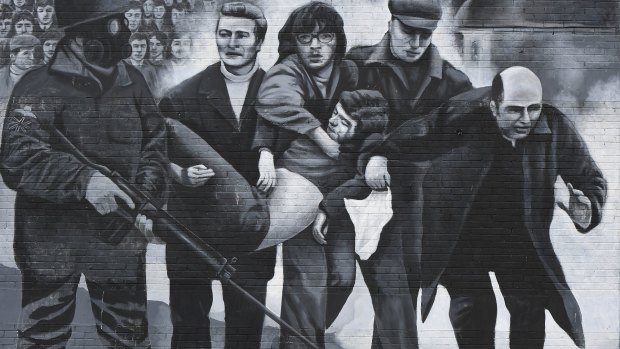
A mural depicting a famous incident during Bloody Sunday.Credit: Getty Images
The Protestant Apprentice Boys of Derry still march annually in commemoration – the parades still prompt discomfort. The Apprentice Boys Hall and its related stories is a stop on the wall walk.
We gaze down at the traditionally majority Catholic/Irish republican area of Bogside with its 12 People's Gallery murals decorating houses near Free Derry Corner, depicting events surrounding the sectarian violence during The Troubles, which severely affected Derry.
It is said that the violent, 30-year conflict over Northern Ireland's constitutional status began in Derry in 1968 with the Battle of the Bogside. Derry also suffered the 1972 Bloody Sunday incident where British soldiers shot 26 unarmed civilians. Former British Prime Minister, David Cameron, issued a formal apology in 2010.
During The Troubles, the walls separated communities and were refortified with military watchtowers.
In the 1600s, Derry was the jewel in the crown of Ulster Plantation, laid out according to best Renaissance town planning principles, imported from continental Europe. That elegance is evident today. From the central Diamond, you can see the four original city gates – Bishop's Gate, Ferryquay Gate, Butcher Gate and Shipquay Gate. More have been added.
Derry also has Europe's largest collection of cannon displayed throughout the city walls. Twenty-four survive – many used during the two 17th-century sieges. John introduces us to Roaring Meg on the double bastion.
All too soon, the tour is over and John collects the modest fee, looking sadly at the five cheapskates who skive off without paying.
His tales have inspired us to continue our explorations. We head down the precipitous Shipquay Street to the 1890 Guildhall outside the walls, to see its magnificent stained glass windows, before crossing the 2011 Peace Bridge.
The Michelin-recommended Browns is tempting for dinner, but the rain and a welcoming hotel convince us to repair to the hotel's packed restaurant, The Gown.
It's a charming place with its restored original wall panelling. A salt and chilli squid salad followed by Greencastle cod with peas, crispy bacon and a red wine sauce is a fine way to end a day in a city that easily earns a happier tag, "Legenderry".
Emirates and Qantas codeshare from Sydney and Melbourne to Dublin via Dubai. See qantas.com.au
STAY
The Bishop's Gate Hotel has doubles from £96 with breakfast. See bishopsgatehotelderry.com
TOUR
Martin McCrossan's City Tours have a guided, one-hour wall walk (includes tea or coffee) departing at 10am, noon, 2pm and 4pm from 11 Carlisle Road. No booking needed. £4 includes tea or coffee. See derrycitytours.com/
Alison Stewart was a guest of Tourism Ireland
Sign up for the Traveller newsletter
The latest travel news, tips and inspiration delivered to your inbox. Sign up now.